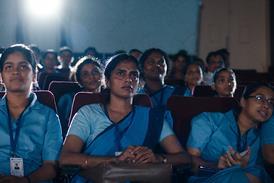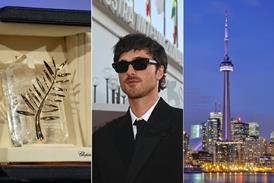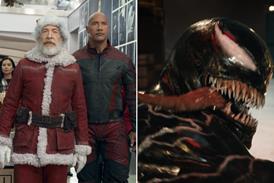Ben Affleck’s third film as director won two Golden Globes and has seven Oscar nominations. Jeremy Kay speaks to the film-makers about revisiting the golden age of 1970s US cinema to tell the film’s outlandish true story.
George Clooney and his Smokehouse Pictures partner Grant Heslov have proven instincts as film-makers. So does Ben Affleck, their director and fellow producer on Argo. But on the morning of January 13 all three could have been forgiven for feeling somewhat unsure about the film’s awards season prospects.
Audiences fell in love with Argo the moment it premiered at Telluride last autumn. An intelligent thriller with a vein of acerbic wit, it wowed the crowds at Toronto and by October was unquestionably the early awards season frontrunner. But while Argo’s pedigree never diminished as the weeks progressed, by the holiday period there had been an imperceptible shift. Other contenders such as Silver Linings Playbook, Lincoln and Les Misérables arrived and were registering with awards groups.
By the evening of January 13 at the 70th annual Golden Globe awards in Beverly Hills, things had changed again. Affleck stunned august rivals Steven Spielberg, Ang Lee, Kathryn Bigelow and Quentin Tarantino to claim the best director prize. For the show’s finale, Argo was named best dramatic picture.
Affleck is not a best director Oscar nominee and thus Academy Awards lore says Argo is unlikely to triumph as best picture. But it has happened before and regardless of what might occur before the Oscar telecast on February 24, the faith has returned.
Indeed, faith was a big part of Argo’s genesis as a film: Chris Terrio, a first-time feature screenwriter with a fondness for the grown-up storytelling of a bygone age, would never have got the job had it not been for the acute eye and confidence of the Smokehouse Pictures chiefs.
It all started when the producers read a 2007 four-page article by Josh Bearman in Wired magazine about CIA operative Tony Mendez’s outlandish plan to set up a fake Hollywood production in Tehran as a ruse to rescue besieged US Embassy staffers during the Iranian Revolution of 1979.
Heslov and Clooney have a deal with Warner Bros and asked the studio to option the material, six years ago. “We met with some writers and Chris Terrio’s take was right in line with the way we saw the film,” says Heslov, speaking several days before the Globes.
Terrio had been at the coalface of the New York independent scene writing spec scripts for years. Nina Wolarsky, a former colleague from the now defunct Hart Sharp, had gone to Smokehouse and she convinced Heslov and Clooney to meet her friend.
Terrio got the job in early 2009 and it took him a year to hammer out the first draft, meeting Mendez and reading his memoirs. “Thirty years had passed since the operation and then it was declassified by Clinton in 1997.
“So I thought what if it had been declassified in 1980 and the film had been made by some film-maker from that period like a Sidney Lumet or written by a William Goldman. What if you could write it as the last 1970s movie - and that’s how the voice of the characters started to come,” says Terrio. He adds: “I wrote the first scene on the back of an envelope, which was the scene where they’re in Hollywood for the reading of the [fictitious] screenplay.
“I thought if you could have a montage where you could jump between the three different worlds of Hollywood, CIA and Tehran, you might begin to hear the words of the screenplay.
“I went down and spent time with Tony Mendez and some of his now-retired peers,” says the screenwriter. “Some of them are Russians who did intelligence work in DC. Tony would say how they were always stressed and felt the weight of what they were doing, so they tried to defuse that tension.”
Meanwhile Affleck had been looking for a new movie to direct. The Town had been released in 2010 and the accompanying reviews confirmed his fine debut on Gone Baby Gone had been no fluke. Pearl Street Films, the company Affleck runs with Matt Damon, also has a first-look at Warner Bros so the studio gave him the Argo script to read. He liked it and signed on to direct and produce in early 2011.
“I met with Chris and it was immediately clear to me how smart he was,” says Affleck, who acknowledges the inherent risks in working with a relative newcomer. “The process is at stake because if you don’t have a working relationship with somebody, you could potentially drag the whole movie down.
“But I just came to realise how talented he was and came to have a huge respect for his opinion. He wanted it to go well for me. Most of all, we became friends. Directing is a lonely job because you’re all alone in the director’s chair but his agenda is the movie too.”
A fitting location
Affleck and Heslov met Mendez - who Affleck also plays in the film - and studied the single chapter in his memoirs about the fake Hollywood production. They wanted to shoot in Iran but with the state of relations with the US being what they were, that would prove impossible. The crew scouted locations and settled on Hollywood, Washington DC and finally Turkey for Iran. Production began in late 2011.
“I went into [the Turkish shoot] with some mild prejudices that I hadn’t realised I held in terms of functionality,” says Affleck, “but things were incredibly smooth in some ways. I hadn’t realised the growth that Turkey had undergone. It provided us with the best look and feel for the Middle East and Persia and there was this incredible friendliness and functionality.”
Heslov picks up the theme: “Turkey also had a lot of Iranian expatriates, although it turned out they didn’t want to be in the film. A lot of them have family back in Iran and they were afraid harm would come to them [if they were involved in the production], which is understandable.”
In the end, Heslov says, they used “a mish-mash” of people. “There are a lot of different people in Istanbul because it’s pretty multicultural.” Turks played Iranian students, while Embassy scenes that shot in Hollywood worked because the producers were able to draw on Los Angeles’ huge Iranian community.
Affleck recalls how the scene in which students storm the Embassy was a challenge. “It was very tough and I cannot take credit for the logistical elements behind it,” he says. “We had 2,000-3,000 Turks show up on the day and they had to get dressed and understand their roles. We put video in the extras’ dressing room showing footage of the actual protests in Tehran and it fired them up. That whole process definitely gave me an appreciation of David Lean movies.”
And all the while, Terrio was there on set, ready to rewrite scenes or amend things here and there. “There are few directors who could be so open to having a sour-faced short guy on set,” says Terrio. “You are always so terrified and thinking, ‘It doesn’t work. The tone is inconsistent. I suck, I suck, I suck.’”
By January 21, Argo had grossed $115.2m in North America and earned two Golden Globes. It would seem a lot of people might disagree with the part about sucking.






















No comments yet